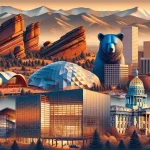Denver, Colorado, is known as the Mile High City because it sits more than 5,000 feet above sea level. This high altitude leads to a unique climate with extreme seasonal variations, diverse microclimates, and weather events ranging from blizzards to heat waves. For residents and visitors alike, Denver’s weather is a point of pride and an ever-present factor influencing daily life.
In This Article
Keep reading to learn about the unique Denver weather conditions you can expect during your visit.
TL;DR
- Denver has over 300 days of sunshine per year but also experiences temperature swings of 50+ degrees between seasons.
- The city sees dramatic snowstorms in winter but also suffers from hot, dry summers and droughts.
- Chinook winds rapidly warm areas even in winter, while mountain towns have their own distinct weather.
- Denver weather affects everything from outdoor recreation to infrastructure planning and gardening schedules.
Seasonal Extremes Shape the Local Identity
Denver‘s climate is classified as semi-arid, with precipitation averaging just 15 inches per year. This allows for over 300 days of sunshine and leads to dry conditions.
In winter, frigid arctic air and snowfall descend upon the region. While daily highs average 45°F from December to February, overnight lows routinely plummet below freezing. Protected by the Rocky Mountains, Denver only sees about 60 inches of snow yearly but blizzard conditions still arise a few times each season.
Normally a windy city anyway, Denver will often experience power outages when strong winds come through the area.
Conversely, summer delivers hot, dry weather courtesy of air masses from the Southwest. June through August highs reach into the 80s and 90s with extremes surpassing 100°F. Cooling thunderstorms provide occasional relief but raise the risk of flash flooding along the Front Range.
Combined with the arid climate, these 50-degree or more temperature swings between winter lows and summer highs characterize the location.
These seasonal extremes shape Denver’s identity and culture. Locals take pride in persevering through harsh winters. Long-term residents reminisce about past blizzards and heatwaves as points of shared history. Transplants find the dramatic shifts invigorating compared to more temperate locales.
Microclimates and Chinook Winds
Differences in topography within Colorado’s Front Range region lead to pronounced microclimates. Mountain towns like Breckenridge and Aspen at higher elevations encounter colder temperatures and snowfall measured in feet rather than inches. Moving west of the Denver metro area, locales in the Foothills see cooler weather with higher precipitation and humidity courtesy of ascending air masses.
But one wild card in Denver’s weather is the Chinook wind. These warm, extremely dry gusts develop when air descends the eastern slopes of the Rockies. As the air compresses, it warms at rates exceeding 5°F per 1,000 feet. Chinook winds can raise temperatures by 25 to 35°F in under 15 minutes, so even frigid winter days may quickly turn mild if these notorious winds kick up.
Outdoor Activities Reign Among Four Distinct Seasons
With abundant sunshine, low humidity, and moderate temperatures throughout much of the year, Denver offers ideal conditions for outdoor recreation. Each season provides its own adventures.
Spring still brings snow to the high country, allowing skiing and snowboarding to continue into June. Denver city parks burst with wildflowers and pleasant weather perfect for biking, hiking, golf, and patio dining.
Summer signals peak tourism season in the Denver area, with temperatures rising and cultural festivals launching. Myriad hiking trails wind through forests and mountains surrounding Denver. At higher elevations, lakes and streams provide cooling relief, while water sports range from whitewater rafting to stand-up paddleboarding. Popular destinations like Red Rocks Park and Amphitheatre host concerts against stunning backdrops.
By fall, brilliant golden Aspen groves beckon visitors to the Rockies. Crisp air in the city makes for invigorating cycling, running, and tennis. Nothing epitomizes fall like cheering on the Broncos at Mile High Stadium. Finally, winter ushers in skiing and snowboarding at world-class resorts. Holiday lights twinkle downtown, where ice skating rinks emerge each year. Cozy cafes and breweries offer warm refuge during the cold, snowy months.
Planning for Impactful Weather
While exhilarating, Denver’s variable and sometimes severe weather requires planning. Protecting infrastructure represents an ongoing challenge. Temperature shifts and freeze/thaw cycles strain roads and bridges. Sudden, heavy precipitation and runoff test storm drainage while snow removal budgets soar. And facilities like Denver International Airport require extensive weather forecasting and preparedness efforts.
Weather variability affects individuals’ commuting, gardening, health, and special events. Commuters must budget extra time for inclement conditions. Gardeners carefully schedule plantings around average first and last frost dates. People sensitive to large swings in temperatures, precipitation, and humidity may suffer more symptoms. Event coordinators regularly monitor forecasts, preparing backup plans as needed.
Adapting to maintain quality of life during weather extremes remains an evolving process. But the region continues making progress to become more resilient. For example, heat warning systems alert vulnerable residents to seek cooler conditions during excessive heat waves. And stricter fire codes and forest management efforts help mitigate wildfire risks that spike during dry years.
Climate Change Intensifies Drought and Fire Danger
Scientists confirm Colorado is already experiencing hotter-than-average conditions due to climate change. Data shows Denver is seeing temperature rises beyond global averages, leading to increased heat wave frequency and severity. Denver also faces heightened drought risk as warmer weather reduces snowpack and dries out soils and vegetation. Sadly, Denver’s air quality has also declined in recent years.
Rising temperatures and periodic droughts have created the conditions for Colorado’s worst wildfire seasons on record. 2020 delivered unprecedented infernos, requiring intense firefighting efforts to protect lives and property. Experts forecast wildfires worsening through the coming decades, so communities balance short- and long-term planning to curb risks.
FAQ
How much snow does Denver receive compared to the nearby mountains?
While Denver averages about 60 inches of snowfall annually, totals exceed 300 inches per year in the higher elevations of the Rockies. So places like Vail and Breckenridge tally 5 to 10 times more snow than Denver city proper.
What is the wettest / driest month in Denver?
May is Denver’s wettest month averaging just over 2 inches of precipitation. January typically brings the least moisture at 0.45 inches on average.
How severe are Denver’s hail storms?
Large hail occurs here more frequently than in most regions. During the May through August storm season, baseball-to softball-sized stones smash windows and vehicles, causing costly damage to roofs, siding, and landscaping.
How long do snowy conditions last in Denver after a blizzard?
The city’s low humidity allows aggressive sunshine and warm Chinook winds to melt snow rapidly, clearing streets and restoring travel within 1 to 5 days, even after a major snowstorm.
Is it safe to vacation and recreate in Denver during the winter?
Yes, with proper preparation, countless tourists safely enjoy Denver and mountain resorts year-round. However, travelers should equip vehicles with snow tires or chains and dress in layers for variable conditions. Checking forecasts and avoiding storms remain ideal.
So while Denver’s weather patterns appear intense, locals embrace the region’s seasonal changes. The Mile High City offers a unique gateway to outdoor adventure against a backdrop of natural beauty. The climate helps instill resilience in Denver residents, some of whom boast “native” status after conquering 30 winters or more!






